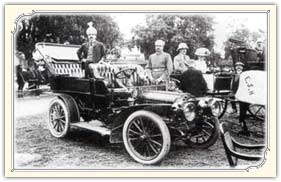 Hyderabad, with its antiquated temples, churches, masjids and monuments is known for its rich and colorful historical background. For centuries, the city and the surrounding region have witnessed the amalgamation of a vast multitude of cultures and races, all of which have left an indelible impression upon this historic city. After the Indian independence, though it remained a separate state for few years, it was later included in the union territory and was made the capital of Andhra Pradesh. Ranging from the Mauryan Empire under King Ashoka, to the British rule in India, the city of Hyderabad has been the epicenter of India's long and turbulent history. Even today, in the era of technological advancement and westernization, Hyderabad has somehow managed to preserve in its bosom, the essence of its rich historical background and inherited cultural diversity. If you wish to learn all about the history of this noble city then here is a detailed account of the magnanimous city of Hyderabad.
Hyderabad, with its antiquated temples, churches, masjids and monuments is known for its rich and colorful historical background. For centuries, the city and the surrounding region have witnessed the amalgamation of a vast multitude of cultures and races, all of which have left an indelible impression upon this historic city. After the Indian independence, though it remained a separate state for few years, it was later included in the union territory and was made the capital of Andhra Pradesh. Ranging from the Mauryan Empire under King Ashoka, to the British rule in India, the city of Hyderabad has been the epicenter of India's long and turbulent history. Even today, in the era of technological advancement and westernization, Hyderabad has somehow managed to preserve in its bosom, the essence of its rich historical background and inherited cultural diversity. If you wish to learn all about the history of this noble city then here is a detailed account of the magnanimous city of Hyderabad. Historical Facts About Hyderabad
- Around third century BC, the region around Hyderabad was a part of the Mauryan Empire. Following the decline of the Mauryan Empire there was an uprise by the Satavahanas who served as the feudatories to the Mauryans and founded their own Empire. The Satavahanas Empire, which ranged from Maharashtra to much of the Deccan plateau, reigned for the more than 4 centuries.
- As the rule of the Satavahanas came to an end, the area was seized by the Ikshvaku dynasty of Andhra. During the next few centuries, the region was ruled by several Hindu and Buddhist kings and eventually came under the rule of the Chalukya Kings. After the decline of the Chalukya dynasty, the state fell under the clutches of the Kakatiyas, who were feudal chieftains of the Chalukya dynasty.
- Later in 1321, the Kingdom of Warangal of the Kakatiyas, were defeated by Muhammad bin Tughluq of the Delhi Sultanate and the whole region had to endure a state of anarchy for few decades. By the middle of the 15th century, the region fell in the hands of the Bahmani Sultanate which controlled the Deccan, north of the Krishna River from coast to coast.
- In 1518, Sultan Quli Qut-ul-Mulk, gained control over the region and constructed the fortress city of Golconda. He proclaimed himself as Sultan Quli Qutub Shah. In 1589, one of his descendants, Muhammad Quli Qutub Shah, established the city of Hyderabad on the Musi River, five miles from Golconda.
- After Shah Jahan, Aurangzeb ascended to the throne and focused on expanding the Mughal Empire. In this pursuit, he took control over Golconda Fort, as Hyderabad was one of the wealthiest cities of the region. Though his initial attempts were thwarted, finally, in 1987 after a nine-month long battle, he captured the Golconda Fort.
- The Mughal emperor in 1724, appointed chin Qulich Khan Asaf Jah I Mir Qamar-ud-Din Siddiqi, who was conferred the title of Nizam-ul-Muk, meaning the administrator of the realm. By the mid-18th century, after the decline of the Mughal Empire, the Nizam-ul-Muk seized control of the region and the Asaf Jah dynasty was founded. The descendants of Asaf Jah ruled Hyderabad as Nizams until India’s independence. During the Nizam rule, Hyderabad was the largest princely state in India. After India gained independence in 1947, the Nizams’ wanted an independent territory as either a sovereign state or under the British dominion. But Hyderabad was strategically important for the newly formed Indian Union and thus, the Indian Army marched into Hyderabad State from five fronts on September 16, 1948 and Hyderabad was forced to surrender and was annexed to the Indian Territory. From 1948 to 1956, Hyderabad remained a separate state within the Indian union. But later, when the Indian states were formed on the basis of language. Hyderabad, owing to its Telegu majority, was made the capital city of the state of Andhra Pradesh.